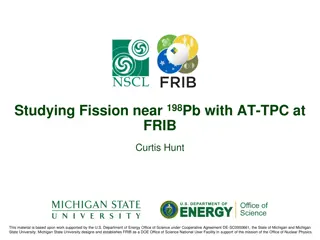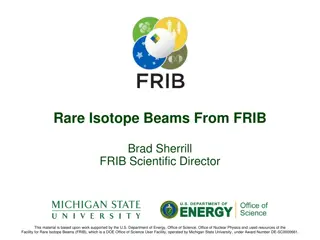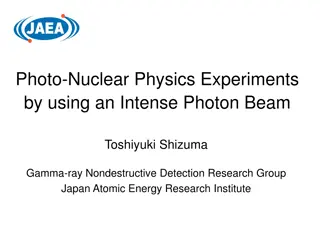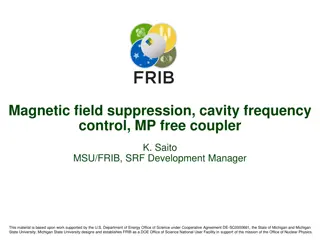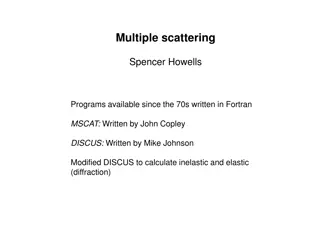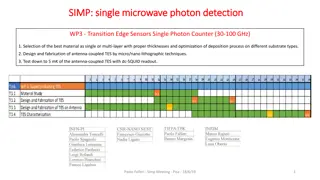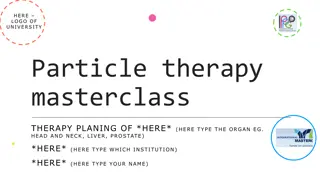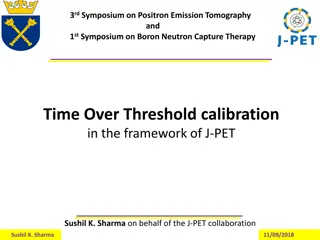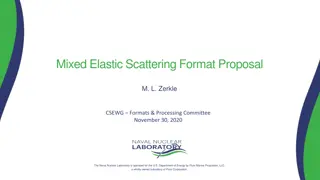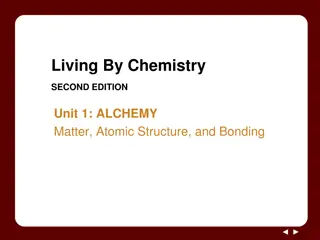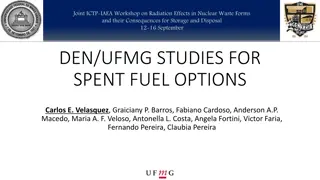Nuclear Structure Investigations with Resonant Photon Scattering at FRIB-TA Workshop
Explore nuclear structure using resonant photon scattering at the FRIB-TA Workshop. The High Intensity Gamma-ray Source facility enables research on photonuclear reactions, spin and parity determinations, and selective investigation of nuclear states. Learn about the technique's potential impact on FRIB science and its role in studying electromagnetic processes and dipole responses of nuclei.
- Nuclear structure
- Resonant photon scattering
- FRIB-TA Workshop
- Photonuclear reactions
- High Intensity Gamma-ray Source
Download Presentation

Please find below an Image/Link to download the presentation.
The content on the website is provided AS IS for your information and personal use only. It may not be sold, licensed, or shared on other websites without obtaining consent from the author. Download presentation by click this link. If you encounter any issues during the download, it is possible that the publisher has removed the file from their server.
E N D
Presentation Transcript
FRIB-TA: Topical Program Nuclear structure with resonant photon scattering: The Technique & Its Relation to FRIB Science Robert V.F. Janssens University of North Carolina Chapel Hill (NC) & TUNL Duke University, Durham (NC) FRIB-TA Workshop 5/16 26/2023 1
Outline Overview of the high-intensity g-ray source (HIgS) Photonuclear reactions and experimental observables g-ray detection arrays at HIgS/TUNL Examples of structure investigations with resonant photon scattering & Potential Impact on FRIB Science FRIB-TA Workshop 5/16 26/2023 2
The HIgS Facility The High Intensity Gamma-ray Source is a Compton-backscattering g-ray source dedicated for nuclear science research. FRIB-TA Workshop 5/16 26/2023 3
The HIgS Facility The High Intensity Gamma-ray Source is a Compton-backscattering g-ray source dedicated for nuclear science research. Linear polarization: 99 % Circular polarization: > 93 % Photon flux: 109g s-1 Bandwidth: 2-5 % of beam energy J. Yan et al., Nature Photonics 13, 629 (2019) FRIB-TA Workshop 5/16 26/2023 4
Photonuclear Reactions at HIgS Use photonuclear reaction to: Explore the evolution of nuclear structure and its impact on global properties such as the nuclear shape, the mass, and decay modes. Study the dipole response of nuclei at energies below the giant dipole resonance Nuclear Resonance Fluorescence (NRF) Well-understood electromagnetic (EM) process Model-independent access to spins, parities, mixing ratios and cross sections Quasi-monochromatic beams explore specific excitation energies A. Zilges, D.L. Balabanski, J. Isaak, N. Pietralla, Prog. Part. Nucl. Phys. 122 (2022) 103903. FRIB-TA Workshop 5/16 26/2023 5
Nuclear Structure with Photonuclear Reactions Selective investigation of isolated states Few-body systems Electric and magnetic dipole strengths Photoabsorption cross section Photon strength functions Photofission cross sections g-decay of the IVGDR Low-energy QCD A. Zilges, D.L. Balabanski, J. Isaak, N. Pietralla, Prog. Part. Nucl. Phys. 122 (2022) 103903. FRIB-TA Workshop 5/16 26/2023 6
Spin & Parity Determinations: Linear polarization at work! Measuring intensities at different positions in and out of plane constrains quantum numbers (spins, parities) Anisotropy of the capture process (beam direction, polarization) Unequal population of magnetic substates Spin- and parity dependent angular distribution of decay gamma rays Iliadis & Friman-Gayer Eur. Phys. J. A (2021) 57:190 FRIB-TA Workshop 5/16 26/2023 7
The Clover Array at HIgS HPGe CeBr 10 (16) clover-type HPGe** and 12 (2 2 ) CeBr detectors. Higher HPGe rates due to segmentation. Higher granularity. No intrinsic radioactivity. Solid angle coverage: 14% **Provided by the Clovershare Consortium, the US Naval Academy, the US Army Research Lab, and TUNL For certain applications: LaBr3 Mesytec Hardware A. D. Ayangeakaa, U. Friman-Gayer, and R. V. F. Janssens Innovation News NetworkWeb link: https://www.innovationnewsnetwork.com/nuclear-structure/10491/ FRIB-TA Workshop 5/16 26/2023 8
g-ray Detectors at HIgS: The 3Setup Synergistic use of up to 4 LaBr and 4 single-crystal HPGe detectors. Flexible suppression of single- photon events using two thresholds. B. Loher et al., Nucl. Instrum. Meth. A 723, 136 (2013) FRIB-TA Workshop 5/16 26/2023 9
Dipole Response of Nuclei: : Neutron Skin in Sn Isotopes Collaboration LLNL (J. Silano, A. Tonchev et al.), TUNL (D. Little, S. Finch, W. Tornow, R.V.F. J et al.) MOTIVATION The origin of heavy elements in the r-process and the structure of neutron stars are governed by the properties of neutron-rich matter Relies on constraining the nuclear equation of state with experimental observables. Novel method to systematically study the evolution of the neutron skin in stable Sn isotopes, Measure the low-energy nuclear dipole strength over the broadest possible range of neutron-to-proton ratios in a single element as input on the neutron skin. Use HIgS to study PDR for 112Sn and 124Sn with 100% linearly polarized photons Do so for isotopic chains where the N/Z ratio can be varied r-process nucleosynthesis Neutron Star Structure N/Z = 1.29 N/Z = 1.48 Advantage of HIg gS: disentangle E1 from M1 strength & do so as a function of E* FRIB-TA Workshop 5/16 26/2023 10
Dipole Response of Nuclei: : Neutron Skin in Sn Isotopes Collaboration LLNL (J. Silano, A. Tonchev et al.), TUNL (D. Little, S. Finch, W. Tornow, R.V.F. J et al.) Nuclear Equation of State (EoS): PDR GDR Neutron skin thickness, rskin, is related to Ssym(?). rskinis directly correlated to the dipole polarizability, D, a measure of the response of the nucleus to an external electric field. DFT calculation (P.-G. Reinhard and W. Nazarewicz, PRC 81, 051303(R)) Credit: J. Silano (LLNL) FRIB-TA Workshop 5/16 26/2023 11
Dipole Response of Nuclei: : Neutron Skin in Sn Isotopes Pygmy Dipole Resonance Giant Dipole Resonance Scissors Mode 112Sn Sn 1 5 10 15 124Sn ( , ) ( ,xn) E (MeV) Selectively measure the E1 photoabsorption strength Excitation energies from 3.5 MeV up to neutron separation (where the Pygmy Dipole Resonance dominates) The dipole polarizabilities of 112Sn and 124Sn were measured to be 9.03 0.23 fm3and 9.11 0.24 fm3, respectively. Credit: J. Silano (LLNL) FRIB-TA Workshop 5/16 26/2023 12
Photoabsorption cross section of 120Sn A.M. Krumbholz et al., Phys. Lett. B 744, 7 (2015) M. M scher et al., Phys. Rev. C 102 (2020) 014317. ?ELBE facility: R. Schwengner et al., NIMA 555 (2005) 211-219. Possible explanation of observed differences Only state-by-state analysis of ground state transitions Unobserved/unresolved strength missing Missing cascade transitions via intermediate levels Quasicontinuum analysis exceeds (p,p') by about 50% Relies on iterative corrections from statistical model Need for an assumption-free approac h FRIB-TA Workshop 5/16 26/2023 13
Photoabsorption cross sections: multi-step decay A.P. Tonchev et al., Phys. Rev. Lett. 104 (2010) 072501. Proton Scattering A. M. Krumbholz et al., Phys. Lett. B 744 (2015) 7-12. J. Isaak et al., PRC 103, 044317 (2021) Bremsstrahlung (NRF): quasicontinuum analysis M. M scher et al., PRC 102 (2020) 014317. ????= ???+ ????? P. Kuchenbrod, Master thesis, TU Darmstadt (2022) NRF @ HIg gS with funnel approach FRIB-TA Workshop 5/16 26/2023 14
NRF at HIgS & Structure of Neutron-Rich Nuclei Purpose: Test further nuclear models shown to be successful in neutron-rich Ni isotopes o Role of tensor force in explaining shape coexistence (see 66Ni, valid also for 68,70Ni) o Is there an impact in stable Ni isotopes; e.g., are the same excitations present? Experimental Approach Deep inelastic reactions @ ATLAS 2n Transfer @ IFIN-HH Multi-step Coulomb Excitation @ ATLAS Neutron Capture @ ILL NRF @ HIgS N. M rginean, D. Little, Y. Tsunoda, et al., Phys. Rev. Lett. 125, 102502 (2020) MCSM predictions for stable 66Ni 66Ni FRIB-TA Workshop 5/16 26/2023 15
NRF at HIgS & Structure of Neutron-Rich Nuclei Tracing in stable 64Ni excitations seen at lower energy in n-rich Ni Monopole x 1.0 Monopole frozen N. M rginean, D. Little, Y. Tsunoda, et al., Phys. Rev. Lett. 125, 102502 (2020) FRIB-TA Workshop 5/16 26/2023 16
Nuclear Resonance Fluorescence of 64Ni 1187 3setup 2177 1187 2177 Unambiguously assigned 15 J = 1-and 4 J = 1+states between 8.5 MeV and 9.2 MeV. Coincidences confirm level scheme Branching ratios, multipole mixing ratios for transitions X. K. James, UNC Ph.D. Thesis FRIB-TA Workshop 5/16 26/2023 17
Nuclear Resonance Fluorescence in 74Ge Why 74Ge? Part of a comprehensive study of all even Ge isotopes (stable and beyond stability) Test further Shell-Model interactions which were so successful in 76Ge S. Mukhopadhyay et al. PRC 98, 014327 0 matrix elements for 76Ge can be represented as a sum over states in 74Ge (n,n ) at UK L Two-nucleon xfer amplitudes B. A. Brown et al. J. Phys: Conf Ser. 966 012017 (2018) B. A. Brown, M. Horoi, and R. A. Sen kov, Phys. Rev. Lett. 113, 262501 (2014) ( , ) at HIGS Experimental Program includes: Coulomb Excitation @ATLAS (GRETINA + CHICO) (n,n g} @ UKAL (g,g ) NRF @ HIgS S. R. Johnson, UNC Ph.D. Thesis FRIB-TA Workshop 5/16 26/2023 18
Nuclear Resonance Fluorescence in 74Ge 74Ge(g,g ) NRF @ HIgS Testing Shell-Model Interactions for J =1 States in 3 6 MeV Range 36 new dipole states identified Observed 20 branches to low-lying excited states Branching ratios for decays of 16 dipole states Multipole mixing ratios for 16 transitions to low-lying excited states Spin and parity determined from count-rate asymmetries in different detector positions: Energy-Integrated Elastic Scattering Cross Section Excite levels with previously measured ??[?] and unknown ?? with the same photon beam. A 1 M1 Can then determine unknown ?? without a direct beam flux measurement. A 1 E1 [1] Bremsstrahlung measurement: R. Massarczyk et al., Phys. Rev. C 92, 044309 (2015) Relative photon flux can be determined from beam energy profile measured with in- beam HPGe. S. R. Johnson, UNC Ph.D. Thesis FRIB-TA Workshop 5/16 26/2023 19
Nuclear Resonance Fluorescence in 74Ge Compare the elastic scattering cross section of discrete 1+ states to predictions of the shell model. S. R. Johnson, UNC Ph.D. Thesis FRIB-TA Workshop 5/16 26/2023 20
Nuclear Resonance Fluorescence in 74Ge Compare distribution in energy of discrete 1-states to predictions in the shell-model picture. S. R. Johnson, UNC Ph.D. Thesis FRIB-TA Workshop 5/16 26/2023 21
The Giant Dipole Resonance (GDR) GDR splits in two humps in deformed nuclei: K=0 and K=1 GDR decays to ~1% internally by E1 -decay Internal decay to 0+and 2+states of K=0 ground-state band Branching ratio of these decays predicted by Alaga rule K-assignments to GDR never tested experimentally Idea: Excite slices of GDR with monochromatic and polarized HI S beam Measure branching ratio through azimuthal angular distribution K=0 K=1 K=0 Alaga rule ?21 ?x 3 K=1 ??? ??? + += 1 B E1;1GDR B E1;1GDR 21 01 + += = ?.? for ?.? for + for ?= =? for ?= =? for GDR 1 J. Speth and A. van der Woude, Rep. Prog. Phys. 44, 719 (1981) B. L. Berman and S. C. Fultz, Rev. Mod. Phys. 47, 713 (1975) FRIB-TA Workshop 5/16 26/2023 22
The Giant Dipole Resonance (GDR) 140Ce in 15.9 MeV linearly polarized -beam: test of technique 21 01 + + ?.??(?) FRIB-TA Workshop 5/16 26/2023 23
The Giant Dipole Resonance (GDR) 154Sm in 12.4 MeV linearly polarized -beam + 1GDR + + 1GDR + 01 21 01 01 J. Kleeman, TU-Darmstadt, Thesis FRIB-TA Workshop 5/16 26/2023 24
The Giant Dipole Resonance (GDR) 154Sm in 12.4 MeV linearly polarized -beam 21 01 + += ?.??(?) J. Kleeman, TU-Darmstadt, Thesis FRIB-TA Workshop 5/16 26/2023 25
The Giant Dipole Resonance (GDR) Measurement points in the GDR of 154Sm 21 01 + += ?.???(??) 21 01 + += ?.??(?) 21 01 + += ?.???(?) 21 01 + += ?.??(?) 21 01 + += ?.??(?) J. Kleeman, TU-Darmstadt, Thesis FRIB-TA Workshop 5/16 26/2023 26
Summary A modern, multi-detector g-ray array has been developed for photo-nuclear reaction studies at HIgS - A multi-faceted program has been initiated exploiting the capabilities of HIgS mono-energetic polarized photon beams of high intensity for now this facility is unique - - The current research program addresses issues in nuclear structure, nuclear astrophysics, reaction dynamics and low-energy QCD - Some examples discussed examples in nuclear structure - the hunt in stable nuclei for new excitations seen in n-rich nuclei - tests of calculations at low spin but high(er) excitation energy - study of dipole response up to the particle emission threshold FRIB-TA Workshop 5/16 26/2023 27
Collaboration FRIB-TA Workshop 5/16 26/2023 28
BACKUP STUFF FRIB-TA Workshop 5/16 26/2023 29
The Ge Isotopes 70Ge -The first 2+state has the highest energy among the first 2+ states of even Ge isotopes. 72Ge The first excited state has a spin parity of 0+and is the lowest in energy among even- even Ge isotopes. 76Ge The second 2+ state has the lowest excitation energy. Indication of triaxiality? Ge isotopes exhibit signatures of both shape coexistence and triaxial deformation FRIB-TA Workshop 5/16 26/2023 30
78Ge FRIB-TA Workshop 5/16 26/2023 31
Exp jj44b FRIB-TA Workshop 5/16 26/2023 32


